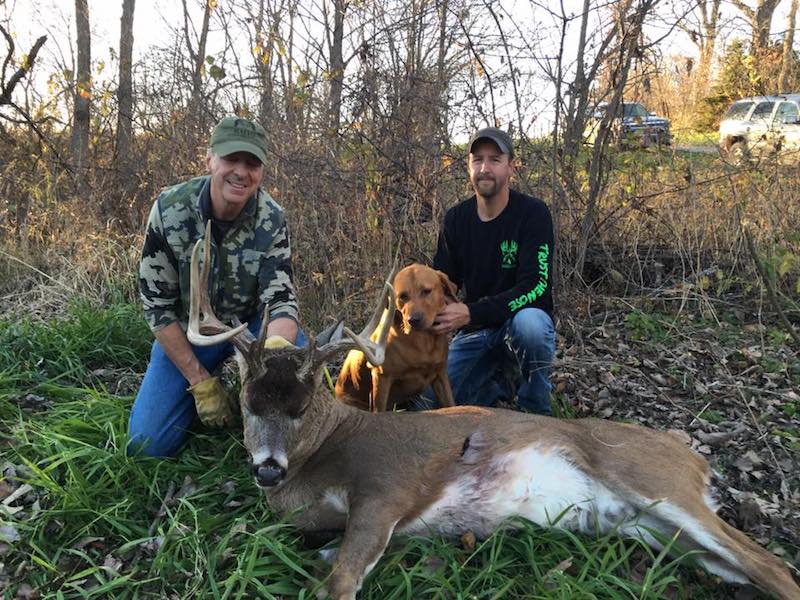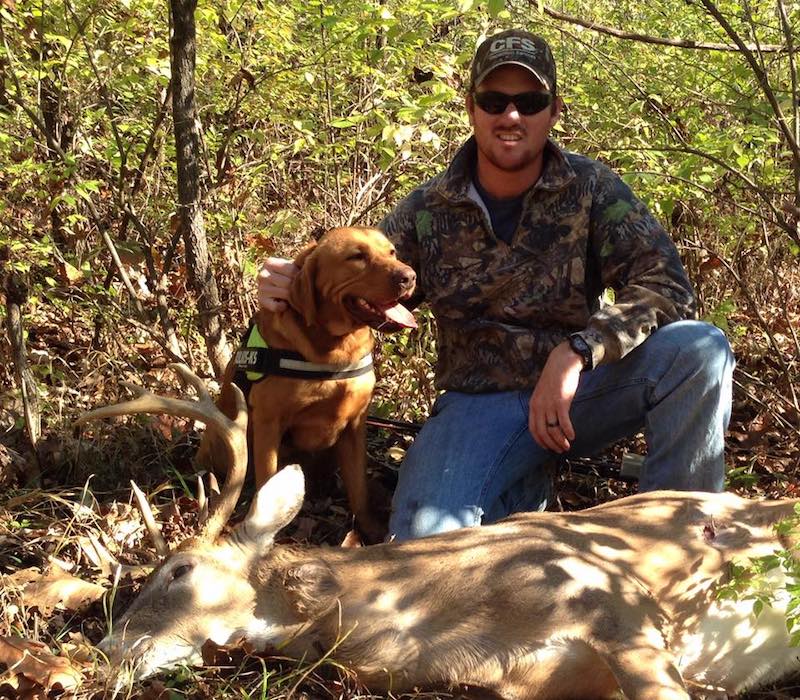The most sinking feeling a bowhunter can experience is that of a blood trail that goes dry without an animal at the end. Wounded and unrecovered game is an unfortunate reality of hunting. But lucky for us, dog trainers like Doug Fink and his four-legged counterparts can help.
Fink belongs to United Blood Trackers and has been working with his yellow lab, Kash, for the past five years to follow the scent of wounded deer. Poor shots, sparse sign, and difficult tracking conditions like fresh rain or snow can make game recovery difficult. That’s where Fink and Kash come in.
“Blood trailing or blood tracking is often a misleading term, because the dog is not actually tracking the blood,” Fink said. “Most of the time when a hunter calls for a tracking dog, it’s because there isn’t enough blood to track by sight.”

Doug and Kash help many hunters track down deer they’ve lost in the woods. Photo Credit: Non-Typical Deer Recovery
Successful game recovery begins with diligently observing the moments immediately following the shot. Gear such as lighted nocks can help bowhunters determine the exact point where the arrow hit the deer.
Note the point of impact and body language the deer exhibits after the hit. According to Fink, a deer’s hunched posture and a slow walk can indicate a hit that was far back into the liver or guts. You can take pictures from the stand to mark the deer’s last known location and direction of travel as helpful reminders when you begin to track. Unless you saw the deer fall, wait at least an hour before climbing down to inspect the arrow for hair and blood. Take pictures of the immediate sign; this is important evidence for determining the next steps when picking up the trail. Bright red blood with bubbles is classic lung blood, while dark red blood indicates a liver shot. Green stomach matter signifies a gut shot.

The color and texture of blood can tell a lot about where the deer was hit. Photo Credit: John Hafner
Because blood trailing dogs aren’t legal in all states, first confirm whether they’re legal where you hunt. If you’re lacking confidence in your shot, it’s best to contact a tracker before starting to track. This reduces contamination and helps the tracking dog quickly identify the deer’s scent. Game recovery dogs follow the scent of a deer’s interdigital gland located in its foot. Well-trained dogs can focus on an individual deer’s scent while ignoring the smell of others in the area.
Fink said the majority of tracking calls he receives are for deer that are not fatally wounded. They often have muscle hits outside the body cavity, leg and shoulder shots, and single-lung shots. Single-lung hits are especially difficult to track because the deer is usually too healthy to catch up to, but can succumb to the wound months later.
“Often we have to cover several miles before calling off the track,” Fink said. “This is unfortunate because we track to the best of our abilities, and we still rarely recover a one-lung deer that the hunter could not recover on his or her own.”
Patience is key when tracking a wounded deer. Fink recommends waiting 8-12 hours on a liver shot and 12-24 hours on a gut-shot deer. Being impatient can “bump” the deer, giving it a surge of adrenaline and drastically reducing the odds for a successful recovery.

Give the deer the appropriate amount of time to settle. Otherwise, you’ll push it farther into the woods. Photo Credit: Non-typical Deer Recovery
“If we cheat these times, there’s a very good chance the deer will still be alive and will require a second visit to recover the animal,” he said. “If a bed is found, realize the deer was more than likely pushed off by the hunter. If a second bed is found, it’s time to evaluate what organs were hit and what might be causing the deer to move ahead of the hunters.”
Fink takes 90-100 tracking jobs per year, and over time he’s noticed trends that impact the gear he takes afield.
“While shot angle and placement is more important than equipment itself, I do see many times when large expandable broadheads are used with a light arrow setup,” Fink said. “This can cause problems with penetration and deflections. My preference is a heavy arrow with a cut on contact fixed-blade broadhead. I don’t get too caught up with the speed of my arrow.”
If you find yourself looking for help this fall, visit the Find A Tracker map with United Blood Trackers. There, you’ll also find a map that shows what states it’s legal to track in using a dog. With the prime days of bow season quickly approaching, do your research ahead of time so you know where to find a helpful nose to recover your deer.